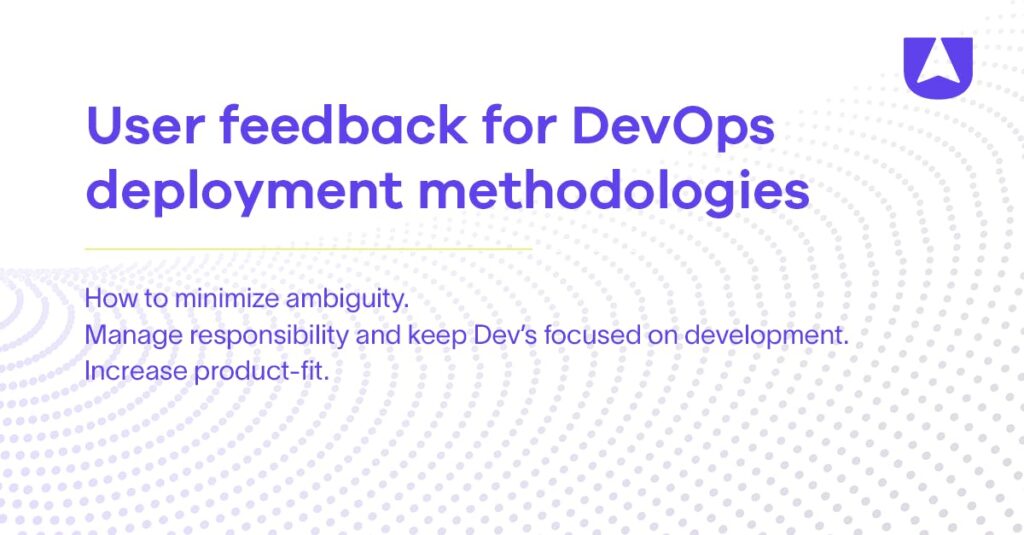User feedback for DevOps is our fourth and final article in the Feedback for Developer Methodologies series. Check out our other articles if DevOps isn’t for your.
- Feedback for Waterfall development methodologies
- Feedback for Agile development methodologies
- Feedback for Rapid development methodologies
Organizations are constantly striving to deploy their applications faster and more efficiently. DevOps is a set of practices that enables this by automating the software delivery process. One way to further improve the speed and quality of deployments is to incorporate user feedback into the methodology.
But why should you care? Because there are several benefits of incorporating user feedback into the DevOps deployment methodology is a great way to improve the efficiency and quality of deployments. User feedback provides organizations with valuable insights into how their applications are being used and can help identify areas for improvement. By incorporating user feedback into DevOps practices, organizations can more effectively deploy their applications and improve the user experience.
What is a DevOps deployment methodology, and why should you add user feedback to yours?
User feedback can be incorporated into the DevOps deployment methodology in a number of ways. One way is to collect user feedback during the development process and use it to improve the application before it is deployed. Another way is to use user feedback to assess the performance of an application after it has been deployed and make changes accordingly.
User feedback can help to catch errors and issues that may not be apparent during testing. It can also help to identify areas of the application that need further optimization. There are a few different ways to incorporate user feedback into the DevOps deployment methodology:
- Continuous user feedback
- A/B Testing
- Canary releases
Continuous user feedback
One way to incorporate user feedback for DevOps is to collect it continuously throughout the development process. This can be done through user surveys, interviews, and beta testing. User feedback collected in this way can be used to make immediate changes and improve the quality of the application before it is deployed.
A/B testing
Another way to use user feedback is through A/B testing. This is a technique where two or more versions of the application are deployed and user feedback is collected to determine which version is preferred. A/B testing can be used to test different features, user interfaces, or even whole applications, by A/B testing on a continuous basis throughout the iterative process that is DevOps, teams can gather feedback for DevOps directly from users during interaction with both approaches and adopt the features, build or app with the most favorable response.
Canary releases
Canary releases are a way to slowly deploy an application to a larger audience. This allows for user feedback to be collected on a smaller scale before the application is made available to everyone. Canary releases can also be used to test new features or updates in a production environment without affecting the entire user base during the iterative process once an application is released ‘into the wild’.
User feedback for DevOps teams is important here because it allows organizations to understand how their applications are being used and identify areas for improvement during these limited releases. If the canary release isn’t being measured and tested with audiences, the purpose and benefit has been missed by software teams – so by incorporating user feedback into the DevOps cycles here, organizations can more efficiently deploy their applications and improve the user experience without impacting the whole of their user base.
How to collect user feedback for DevOps teams that move fast
Speed is king when it comes to the DevOps world. So it figures the key to feedback is also speed. Software teams need to think about user feedback as a real-time information collection point and look to adopt more modern user feedback platforms, not wait around for email surveys that receive very low response rates, and user feedback sessions that take weeks to arrange. Feedback for DevOps that’s slow to organize, screen, prioritize and distribute will be redundant by the time it hits the workflow of todays speed orientated teams.
Integrating a user feedback platform into the web application or web site in question allows teams to receive feedback instantly, at the time when users are encountering their error, ‘ah-ha’ moment or are brainstorming what they need on your behalf. This feedback needs to have evolved beyond online form submissions trying to explain the issue at hand, which inevitably end up with a Developers response something like ‘could not recreate error, ticket closed’ or a feature request being misunderstood. In today’s world, feedback can and should be collected with the support of visual elements, screen capture with annotations, video and full session replays to support developer teams.
When collecting this visual feedback, make it easy on users to identify themselves to further your understanding of the submission, by making it easy and only asking for basic fields of information to identify users, you’ll dramatically increase submission volume. You can, and should, automate everything else.
Once collected through a form, it’s about prioritization and action. Modern tools take the hard work out of this with screening steps you can take to approve submissions and features available to allow your users to like or upvote existing feature-builds and bug fixes already submitted so you can stack rank and prioritize without the manual overhead instantly as users contribute to their own ‘user suggested roadmap’.
Attaching it to existing workflows is key to succeeding
Of course, with all the good work done collecting and organizing, the exercise is a redundant one if the top requested features and prioritized bug fixes don’t land in DevOps workflows already existing. The reality is software teams have enough point solutions and siloed pieces of information that if user feedback creates another silo, its going to become less effective at making its way into the next iteration of the DevOps cycle. So any tooling under consideration for user feedback must have the integrations and API capabilities needed to take the actioned, widget collected user feedback and put it in your developer tools like Jira or others. Without this step to collecting feedback, the impact of user feedback on your DevOps is going to remain limited.
To summarize, user feedback for DevOps is important because it allows organizations to understand how their applications are being used and identify areas for improvement. By incorporating user feedback into the DevOps deployment methodology to allow the organization to more efficiently deploy their applications and improve the user experience. In turn, this will lead to more growth opportunities as market fit increases and customer satisfaction leads to better retention. A win-win for business and users alike.
Trusted by over 20,000 software teams and counting, Userback is the best way to get the user feedback you need to support an Agile Development approach. and see how Userback can help you take your SaaS development to new heights!



